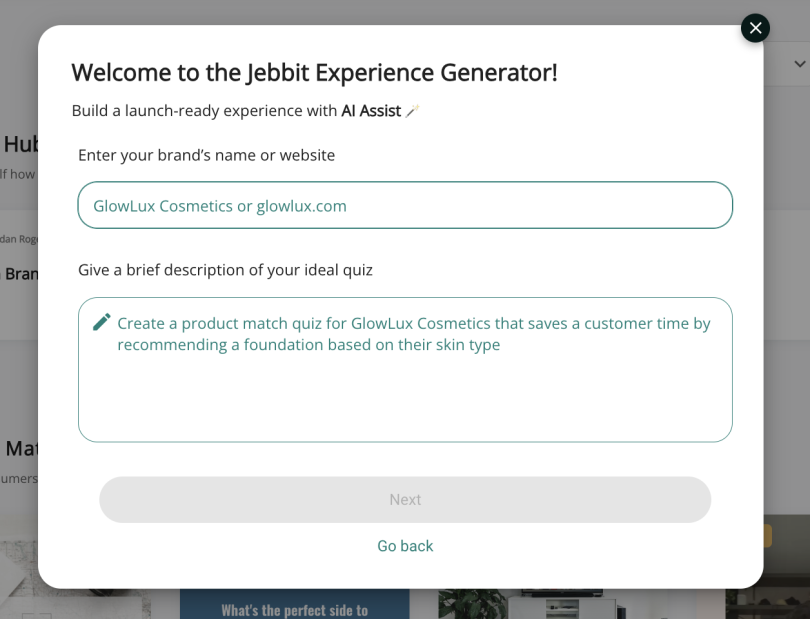In an increasingly competitive online world, staying connected with customers is a challenge for any company. That’s where Jebbit comes in.
The marketing tech platform helps brands build no-code creative solutions to engage consumers, and recently, Jebbit has embarked on an AI integration journey. Spearheaded by Chief Product Officer Jon Sussman, the company is committed to unlocking the potential of AI to revolutionize user experiences and campaign performance.
“The most powerful ways Jebbit can benefit from generative AI is to provide content and creative inspiration, drive significant efficiencies in experience creation and improve the performance of our clients campaigns,” he said.
“The most powerful way Jebbit can benefit from generative AI is to provide content and creative inspiration.”
According to Sussman, incorporating AI into the Jebbit platform has been a long-standing vision. As new open source models became available, Jebbit’s team saw new possibilities for accelerating the development of AI tools within the platform.
Since launching the Experience Generator in spring 2023, Jebbit’s work in generative AI has become a core part of the platform.
This innovative tool allows Jebbit’s clients to simply provide a prompt outlining what they want to create, and within seconds, the AI-powered Experience Generator generates copy and layouts.
In January 2024, Jebbit added the AI Product Assistant to their AI-powered toolbox. This tool focuses on delivering AI-driven outcomes for customers running quizzes. The initial performance has received positive feedback, highlighting its effectiveness in enhancing user engagement and overall campaign success.
“While we have officially rolled out two full-fledged AI-powered product offerings, we’re still in the beginning stages of how we believe AI could benefit our customers mid- and long-term,” Sussman said. “We have a lot more great innovations we’ll be bringing to market in 2024.”
Built In heard more with Sussman to learn more about the innovations that will shape the future of creative platforms in the digital era.
We leaned on third-party tools that specialize in generative AI models such as OpenAI. As soon as their APIs became available, we became early adopters and immediately assembled an AI research and development team within Jebbit. While we had no shortage of ideas and use cases of ways we could leverage the technology, it required a great deal of testing and proof of concept to better understand the feasibility and impact this nascent tech would have on our product. The quality of results, the system performance and overall approach informed the technical design, user experience and workflow around the use case. While we got to market laser quickly, the initial goal was to analyze the usage, the trends, talk to our customers and continue to improve on our first iteration.

What role did you play in developing and launching these generative AI projects?
Working with a third-party service, especially nascent large language models, had many unknowns, so we needed to be very careful along the way to not go down too many rabbit holes and stay focused. Sometimes the ideas and what-ifs outpaced where the technology is today. We needed to take a practical approach to achieve the most value for our customers given certain constraints. There was also a flood of vendors popping up every day and required a great deal of discipline to work through the noise. For example, there were a non-trivial amount of times when the service was either down or had high latency, and we needed to figure out how to bake that into our application and what the user experience would look like in those instances.
The most important thing we can do as leaders is be communicative about the why and the potential impact while also being clear that not all research will lead to productization. Creating an environment of testing and brainstorming has helped us drive innovation.
What obstacles did you encounter along the way? How did you successfully overcome them?
The first plan of action was creating an inclusive environment of collecting inputs and brainstorming ideas from anyone who had them. This meant feedback sessions and surveys with all Jebbit employees and customers.
Once we researched and vetted the ideas, we built out a mini roadmap of research projects to pursue. We then assembled an AI pod which spanned members of the product and engineering team with special guests from other groups. The pod included a data analyst, a product manager and a couple of engineers to build out proofs of concept.
Once a proof of concept or idea was proven feasible, we identified some alpha customers to try it. For example, we rolled out the AI Product Assistant with a few alpha customers to evaluate the quality of the matched quiz recommendations and the underlying performance of the campaigns — it took lots of AB testing! The alpha program did not include a full productized offering but still was able to validate the effectiveness and KPIs we set.
When the alpha was validated, we moved into the normal product development process to establish our first productized version in the market.
How did your team collaborate in order to get this across the finish line?
There are a couple of key qualities that truly stick out across our product dev team and general culture throughout the company.
First, I love how engaged and passionate our customers and Jebbit employees are about our product. There is no shortage of feedback or people interested in brainstorming sessions, which makes our job that much more enjoyable. It also makes the input and prioritization process much easier for the product team. This is the most accessible and inclusive product team I’ve ever been a part of.
The second quality is that we are data obsessed, but we also acknowledge a big part of the decision-making process is understanding our customers and using our gut. We will never have the perfect amount of data. A big part of our rollout process is defining our KPIs and how we plan to tactically track and measure the usage of our features. Analyzing the data, watching user sessions and conducting customer interviews post-launch are all key to iterating on what we ship.







